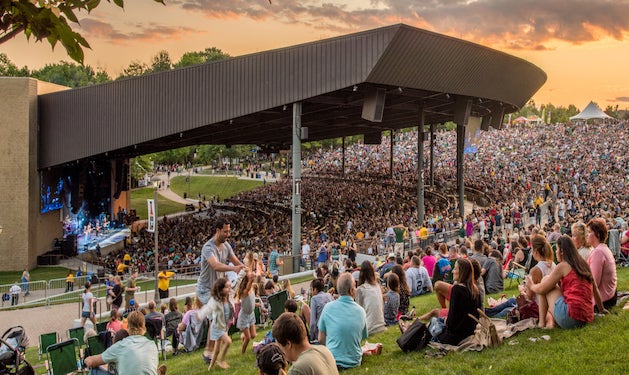Woodstock Tributes at Bethel Woods Concerts
Performing at the site of Woodstock inspires some artists who weren’t there in 1969 to pay tribute by covering a song or artist from the festival. As Bethel Woods gears up for the opening of the 2025 concert season, let’s count the ways that artists of the last concert season acknowledged Woodstock from the Pavilion Stage.
This list begins with 2024, and will be updated from there with tributes from previous and future seasons.
2024
In early July, Joan Jett and the Blackhearts played Sly and the Family Stone’s “Everyday People.”
August brought two days of Pretty Lights, and the EDM act’s sets contained many nods to Woodstock. They incorporated parts of Jefferson Airplane’s “White Rabbit” and “Somebody to Love” and elements of “Mama Tried”, the Merle Haggard tune which the Grateful Dead covered at Woodstock. Derek Smith sang, “With a Little Help from My Friends” Joe Cocker’s Beatles cover, and they also played “I Put a Spell on You”, the Screamin’ Jay Hawkins song covered at Woodstock by Creedence Clearwater Revival. They included parts of songs by Woodstock alumni Sly & the Family Stone (“Family Affair”) Jimi Hendrix (“All Along the Watchtower”) and Crosby, Stills, Nash & Young (“Our House”) that were not performed at Woodstock.
Also in August, Margo Price ended her set with Janis Joplin’s a capella “Mercedes Benz” (which wasn’t on Joplin’s Woodstock setlist), and earlier in the show she played “Woodstock,” by Joni Mitchell who famously regretted not performing at Woodstock.
That evening's headliners, Tedeschi Trucks Band, started their encore with “A Song for You” by Leon Russell, who played piano at Woodstock in Joe Cocker’s band, the Mad Dogs and Englishmen. (In 2015, Tedeschi Trucks spearheaded a Mad Dogs and Englishmen reunion with Russell.) Together with Margo Price, the band ended with “Sing a Simple Song” by Sly and the Family Stone.
2023
Counting Crows played the Grateful Dead’s “Friend of the Devil”, which was not one of the five songs the Dead played at Woodstock, but they introduced it by telling how they learned the song for late night shows in New Orleans when they were starting out.
2022
Brandi Carlisle, during her first visit to Bethel Woods, described from the stage being at the Woodstock site during its anniversary month: “Absolutely amazing, I could feel the love and peace and spirit coming off of the ground.” Then she covered Joni Mitchell’s “Woodstock.”
2019
When Rngo Starr’s All-Starr band performed for Woodstock’s 50th anniversary, it was bound to have some Woodstock covers. For one thing, keyboardist/singer/songwriter Gregg Rolie had played Woodstock in Santana, and Ringo Starr and His All Starr Band’s setlist included “Black Magic Woman/ Gypsy Queen”, the former which was performed at Woodstock, and Tito Puente’s “Oye Como Va,” which Santana covered after Woodstock. They ended with “With a Little Help From my Friends,” the Beatles tune which had its Woodstock moment via Joe Cocker.
2007
When Mountain performed at Bethel Woods in 2007, original Woodstocker Leslie West paid tribute to possibly the most famous riff of Woodstock, from Hendrix’ version of “Star Spangled Banner”.
1960s History
The 1960s marked a transformative era in global culture and history, characterized by profound social and political upheaval, artistic innovation, and a spirit of rebellion against established norms. Emerging from the post-war period, this decade witnessed seismic shifts in civil rights movements, anti-war protests, and a burgeoning counterculture challenging traditional values.
At the heart of this cultural revolution was the Woodstock Festival, held in August 1969 in Bethel, New York. Billed as "An Aquarian Exposition: 3 Days of Peace & Music," Woodstock became an iconic symbol of the era's ethos of love, unity, and creative expression.
Oral History
Since 2020, the Museum has been deeply committed to the collection and preservation of stories from the people who know Woodstock best. In 2024, the Museum was awarded a major federal grant from the National Endowment for the Humanities to continue the oral history pop-ups that were so successful last year.
Throughout 2024, Museum curators are travelling the country and across New York state to capture your unique stories with an overall goal of collecting 4,500 Woodstock stories from the people who attended the festival. That is only 1% of those who found their way to Yasgur’s Farm. Yet this archive will be the most significant collective memory of the Woodstock Music and Art Fair and will be a defining legacy of the Museum.
All Things Bethel Woods
More than just a venue, Bethel Woods Center for the Arts embodies a legacy of creativity, activism, and social change, inviting visitors to connect with the transformative spirit of Woodstock while embracing the timeless values of peace, love, and understanding. Whether attending a concert under the stars or exploring the museum's rich tapestry of exhibits, visitors are invited to experience the magic of Bethel Woods and be inspired by its enduring message of hope and unity.
Bethel Woods BlogBethel Woods BlogBethel Woods BlogBethel Woods BlogBethel Woods BlogBethel Woods BlogBethel Woods BlogvvvvBethel Woods BlogBethel Woods BlogBethel Woods BlogBethel Woods BlogBethel Woods BlogBethel Woods BlogBethel Woods BlogvvvBethel Woods Blog
